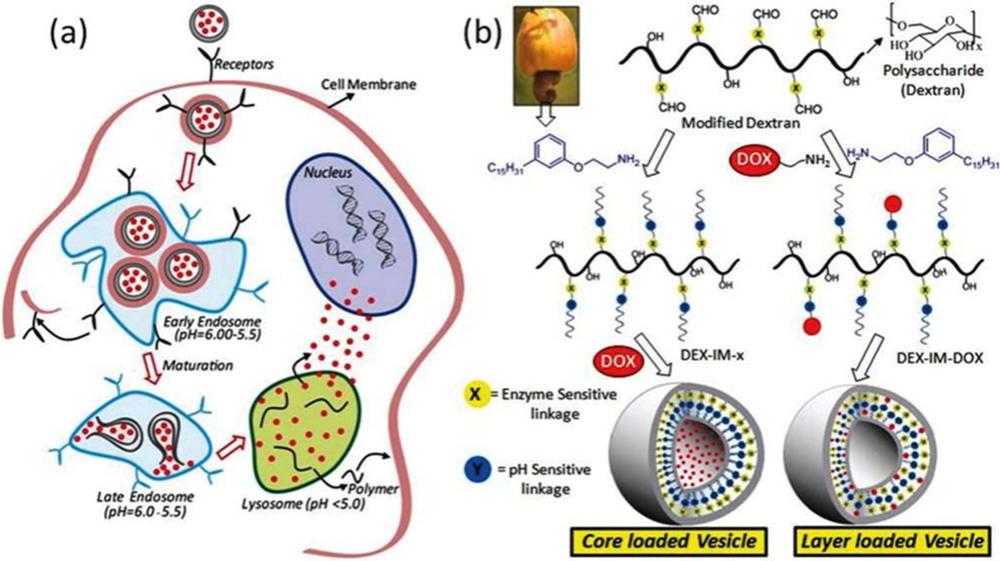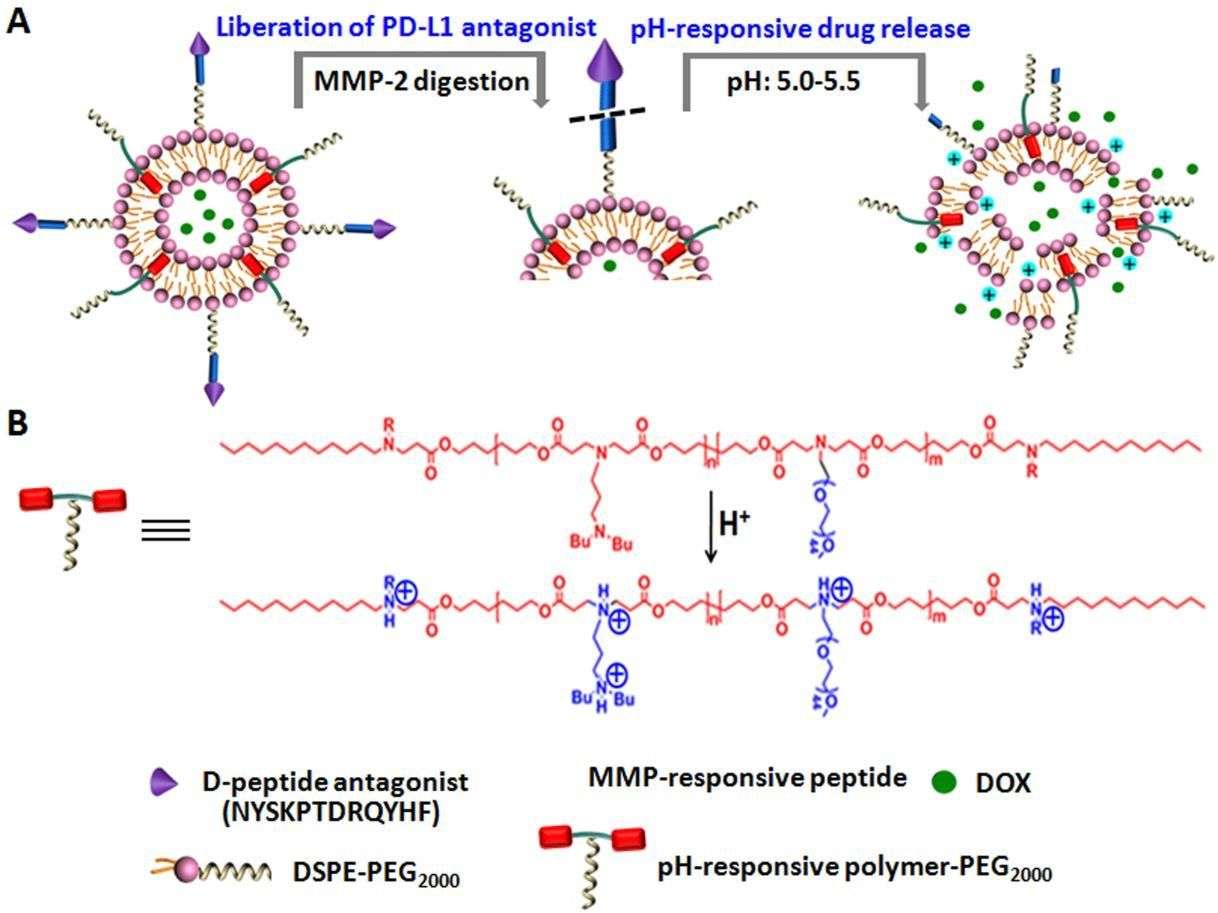Custom pH-enzyme Responsive Liposome Service
Inquiry
pH-enzyme responsive liposomes represent a cutting-edge drug delivery system, effectively utilizing dual stimuli to precisely control the release of therapeutic agents in response to specific pH levels and enzymatic activity. CD Formulation supports the development of high-performance liposomes that respond to pH and enzymes using advanced technology.
Mechanism of pH-enzyme Responsive Liposomes
Enzyme-sensitive release systems typically rely on elevated enzyme expression levels to catalyze biochemical transformations that trigger drug release within a specific tumor microenvironment. These enzymes can also serve as biomarkers for diagnosing or prognosticating tumor stage. In a pH- and enzyme-double-responsive liposome delivery system, cargo can be released upon demand, either through exposure to acidic environments (such as those found in tumor cells and inflammatory tissues) or via selective enzyme binding.
 Fig.1 Schematic of the structure of pH/enzyme dual stimuli-sensitive nanoparticles. (Karimi, Mahdi, et al., 2015)
Fig.1 Schematic of the structure of pH/enzyme dual stimuli-sensitive nanoparticles. (Karimi, Mahdi, et al., 2015)
Our pH-enzyme Responsive Liposome Customization Service
Study on the mechanism of pH and enzyme triggering
By investigating pH and enzyme-triggered mechanisms, we support our clients in developing innovative dual-responsive liposomes, providing fresh perspectives and strategic approaches.
- Development of enzyme-degradable lipids and pH-sensitive lipids
Lipids, as a crucial component influencing the bilayer structure of liposomes, can serve as pivotal regulators of stimulus-response. Through this service, we help clients develop enzymatically cleavable lipids (PEG-MMP-2-lipid) or pH-sensitive lipid varieties.
- Coordinated triggered response strategy
The service focuses on coordinating the regulation of liposomes by utilizing polymer-containing liposomes and enzymes to induce enzyme-triggered conformational changes, thereby facilitating the release of the liposomal contents, e.g. P(NIPAM-co-MAA-co-ODA)and glucose oxidase.
- Investigation of Mechanism Types Responsive to Enzymes
We divided the study of enzyme response mechanism into extracellular enzymes and intracellular enzymes, including matrix metalloproteinase, urokinase-type plasminogen activator, elastase, prostate-specific antigen (PSA), intracellular enzymes, and other enzymes.
Characterization and analysis
We offer a range of analyses for custom liposome products such as physical and chemical properties, in vivo, and in vitro analyses.
Our Platforms for pH-enzyme Responsive Liposome Customization
| Techniques and Platforms |
Specifics |
| pH-enzyme Responsive Development Platform |
- To support the study of the trigger mechanism of pH and enzyme stimuli.
- Study on the binding strategy of trigger factor and liposome.
- Study on the various types of enzyme-triggered mechanism
|
| Product Application Platform |
- To support the development of levels and purity appropriate for specific application scenarios (imaging field, therapeutic field of immunology, etc.).
|
| Characterization Platform |
- Physical and chemical characterization.
- In vitro and in vivo characterization.
- Advanced analytical instruments for in vitro and in vivo analysis.
|
Why Choose CD Formulation?
- Intelligent pH/enzyme dual-responsive delivery system development platform. The platform supports the development of innovative pH-enzyme dual-responsive liposomes, from formulation development and process optimization to analytical characterization, aiming to provide highly efficient and intelligent dual-responsive liposomes.
- The proficient team. The leadership of our technical team is comprised of a cadre of seasoned experts boasting extensive professional knowledge and experience in the field, as well as diverse academic backgrounds spanning multiple disciplines.
- Advanced analytical equipment and platform. The platform is equipped with state-of-the-art analytical instruments to verify physical and chemical indicators, as well as conduct in vitro and in vivo analyses, systematically describing the quality of customized products.
Published Data
Technology: PD-L1 inhibitor conjugate polymer-liposomes technique
Journal: Biomacromolecules
IF: 6.0
Published: 2019
Results: Here, the authors constructed liposomes with a matrix metalloproteinase (MMPs) reactive portion and PD-L1 inhibitor conjugate, combined with low-dose chemotherapy, to achieve enhanced antitumor efficacy. After introducing the pH-responsive polymer into the polymer-liposomes (LPDp), the co-assembly is almost stable under physiological conditions and in the tumor microenvironment and releases the loaded material on the lysosome. Compared to free PD-L1 inhibitors, LPDp improves the biological distribution and on-demand release of peptide inhibitors in tumor areas.
 Fig.2 Schematic representation of tumor microenvironment pH/enzyme dual-responsive polymer-liposomes. (Liu, Ya, et al., 2023)
Fig.2 Schematic representation of tumor microenvironment pH/enzyme dual-responsive polymer-liposomes. (Liu, Ya, et al., 2023)
With state-of-the-art technology and platforms, CD Formulation strives to deliver the most intelligent pH/enzyme dual-responsive liposomes. If you require any assistance, please do not hesitate to contact us.
References
-
Karimi. Mahdi, Sahandi. Parham, et al. Smart Internal Stimulus-Responsive Nanocarriers for Drug and Gene Delivery. 2015.
- Liu, Ya, Qiao Zeng ying, et al. Tumor Microenvironmental pH and Enzyme Dual Responsive Polymer-Liposomes for Synergistic Treatment of Cancer Immuno-Chemotherapy. Biomacromolecules. 2019.
How It Works
STEP 2
We'll email you to provide your quote and confirm order details if applicable.
STEP 3
Execute the project with real-time communication, and deliver the final report promptly.
Related Services

 Fig.1 Schematic of the structure of pH/enzyme dual stimuli-sensitive nanoparticles. (Karimi, Mahdi, et al., 2015)
Fig.1 Schematic of the structure of pH/enzyme dual stimuli-sensitive nanoparticles. (Karimi, Mahdi, et al., 2015) Fig.2 Schematic representation of tumor microenvironment pH/enzyme dual-responsive polymer-liposomes. (Liu, Ya, et al., 2023)
Fig.2 Schematic representation of tumor microenvironment pH/enzyme dual-responsive polymer-liposomes. (Liu, Ya, et al., 2023)
